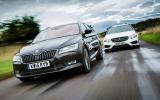There are two kinds of car enthusiast. I used to be one of the normal kind – we’ll call them ‘group one’ – but I’ve changed. Life has turned me into a ‘group two’ sort of feller.Here’s how you tell. Imagine a gleaming, box-fresh, 500bhp estate car parked 50 feet in front of you, in dead-on profile.
The passenger doors are all closed but the bonnet and tailgate are both open. So where do you go first?
‘Group one’ car buffs are drawn straight to the front, like wasps to a sugar cube, to gawp at the hulking lump of engine confined therein. It’s understandable. A few years ago, I’d have been the first one there. You don’t know an engine until you’ve stared at it for at least 10 minutes.
Blog - Is your car a leftie, a rightie or both?
But these days I’d amble to the rear end first with all of the other ‘group two’ pragmatists, wondering whether the rear seats fold totally flat and how many cargo nets and lashing points one gets on a 500bhp load-lugger in 2015. Living with cars turns you into a ‘group two’ sort of bloke, I reckon. It teaches you that, regardless of what they are, big estates in particular only really earn their corn by what they can actually do for you.
Welcome, then, fellow ‘group two’ types. The following test is for you. It contains minimal references to powerful turbocharged multi-cylinder engines, and I’ll keep the sections about performance and handling short and sweet. Because we’d sooner read about load space, in marvellous, gratuitous detail, wouldn’t we?
And we’re all very excited that there’s a new estate on the block with a load bay of apparently unprecedented vastness. The Skoda Superb has an exceptionally large boot even in normal hatchback form, but as an estate, that hold grows to the kind of volume you’ll need binoculars to truly appreciate: up to 1950 litres, as claimed.
That makes any other wagon available for the same money look tiny. On paper, it even eclipses the carrying capacity of the estates that spring to mind as the most capacious and most useful available at any money – Mercedes-Benz E-Class (1855 litres) included.
Read the full Skoda Superb review
Doesn’t that make this new Skoda the best estate in the world, then? In order to answer that question, you need an all-time load-lugging great to compare it with, such as the latest Mercedes E220 Bluetec – as well as a tape measure. You’ll need some props, too. Bald statistics seldom reveal where real-world brilliance is to be found, after all. And parting a two-year-old from her trike, as it turns out, is relatively easy on a rainy afternoon.


































































































Join the debate
Add your comment
I prefer the rear light on
Merc vs Skoda
I feel like i'm in Germany,